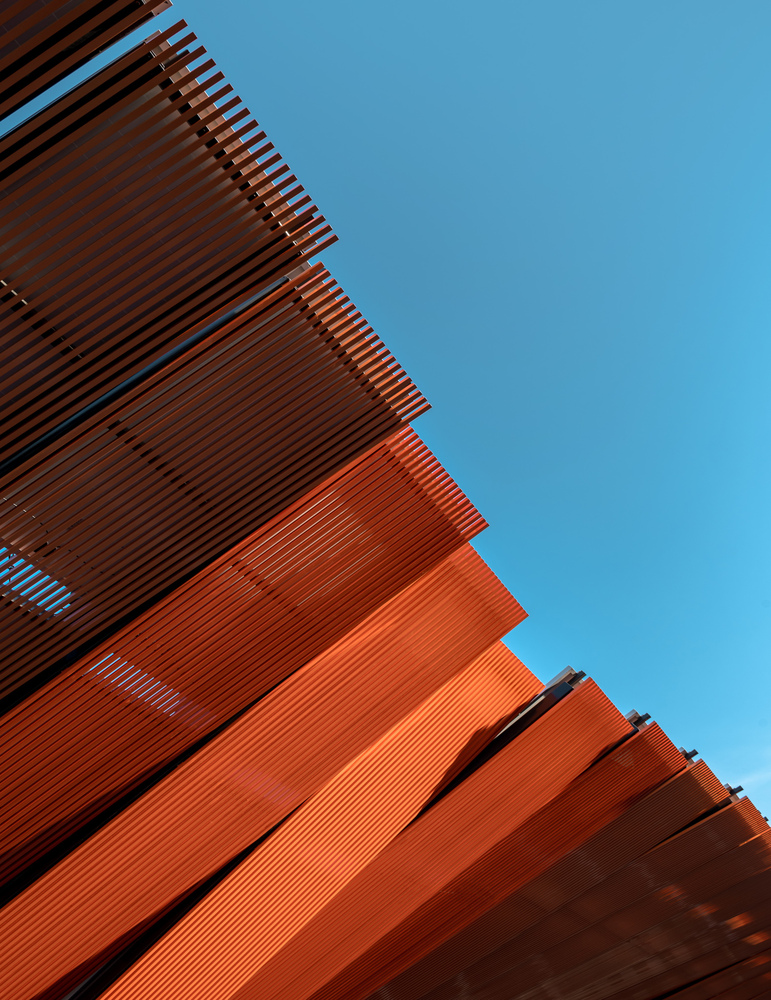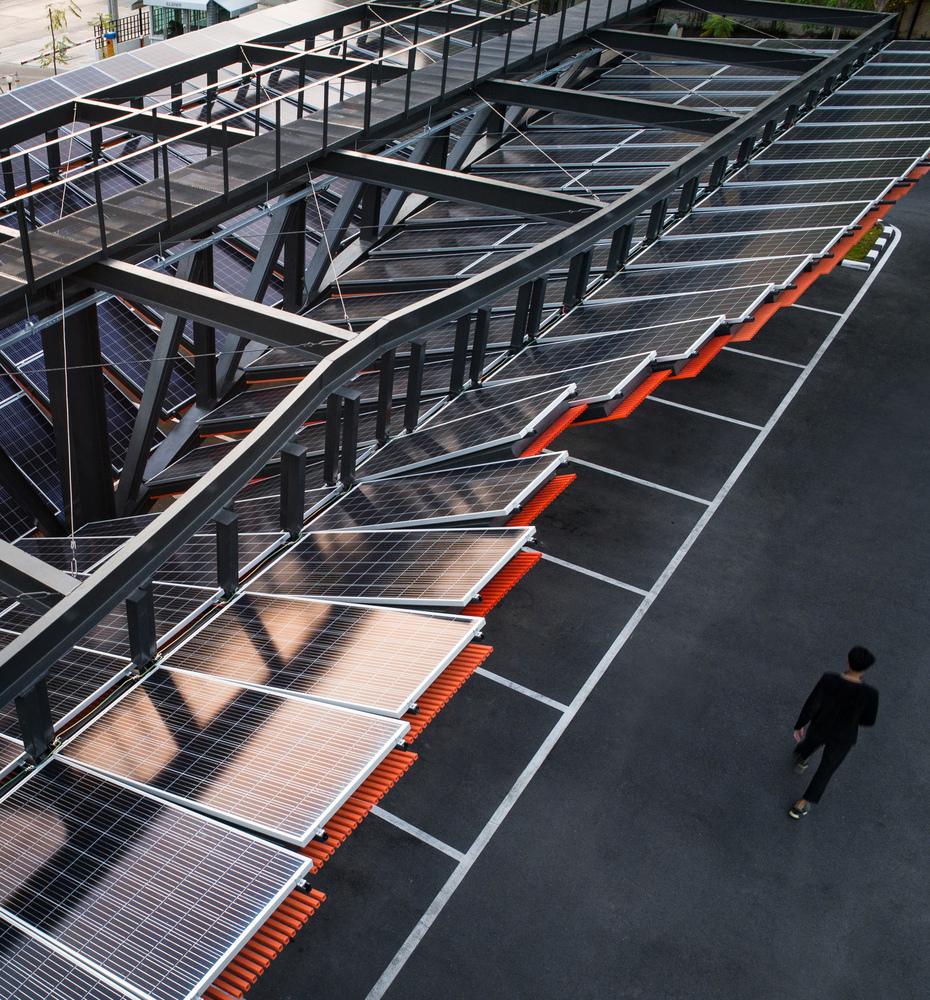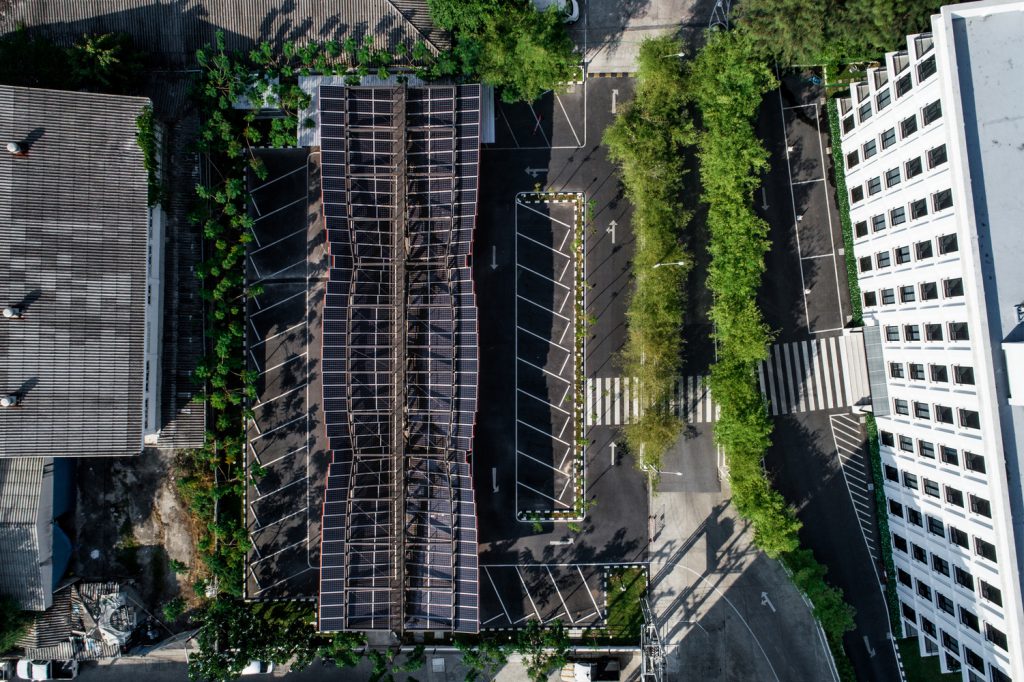Openbox has turned an ordinary parking lot brief into a design with extraordinary values.
Text: Warut Duangkaewkart
Photo Courtesy of Openbox Architects and Panoramic Studio except as noted
Download the online journal Issue 04 Towards Circular Living Click here
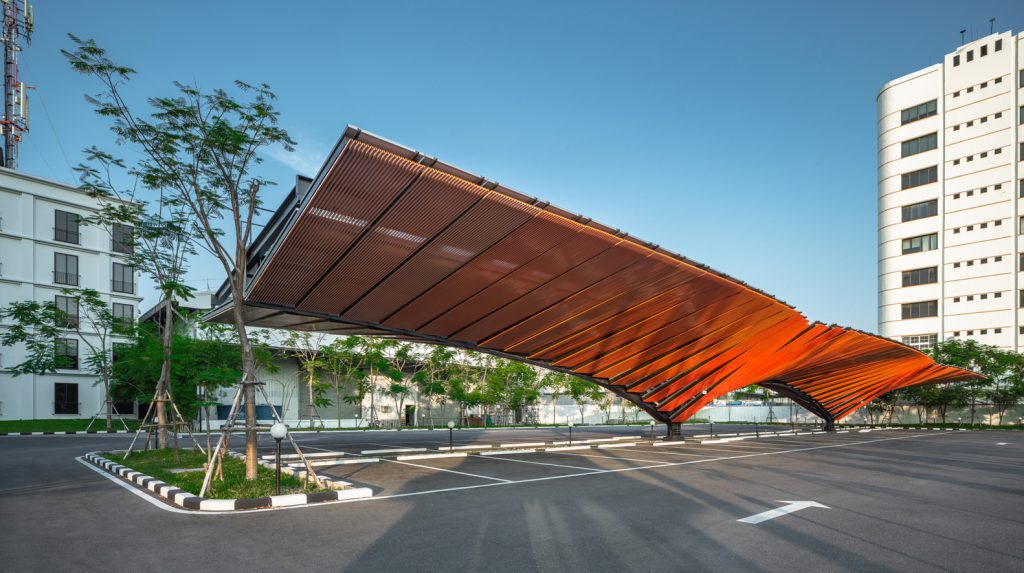
Circular Living ในแง่ของการอยู่อาศัย อาจหมายถึงบ้านพักอาศัยที่มีการบริหารจัดการพลังงานน้ำ พลังงานไฟฟ้า และการใช้ทรัพยากรต่างๆให้คุ้มค่า ส่วนอาคารสำนักงานขนาดใหญ่นั้น หากมีการออกแบบตั้งแต่เริ่มต้นในการจัดการพลังงานจะสามารถวางแผนได้อย่างมีระบบ ซึ่งเป็นส่วนหนึ่งในการวางรากฐานขององค์กร และสร้างภาพลักษณ์ในเชิงอนุรักษ์พลังงาน แต่สำหรับโครงการที่ต่อเติมภายหลังนั้น เป็นความท้าทายที่ต่างออกไปของนักออกแบบ ที่นอกเหนือประเด็นเรื่องของการจัดการพลังงาน แต่เป็นการบริหารจัดการต่างๆ ในแง่ของการจัดการพื้นที่ ความคุ้มทุน และความเหมาะสมกับบริบทที่มีอยู่เดิม ซึ่งหากมุมมองในเรื่องต่างๆ เหล่านี้ ระหว่างผู้ออกแบบและเจ้าของโครงการที่มีมุมมองเป็นไปในทางเดียวกัน จะช่วยให้โครงการที่เกิดขึ้นนั้นมีประสิทธิภาพมากขึ้น
Power Wing คือโครงการของ B Grimm ซึ่งเป็นบริษัทวิศวกรรมเก่าแก่ที่ทำเรื่องเกี่ยวกับผลิตพลังงานไฟฟ้า และ พลังงานทดแทนมาเป็นเวลานานกว่า 100 ปี ซึ่งได้มีโอกาสร่วมงานกับ Openbox Architects มาหลากหลายโครง โดยทาง Openbox เองนั้น ก็มีความสนใจในเรื่องของ Zero Waste Energy มานานแล้ว จึงทำให้มีโอกาสได้ร่วมงานกัน และนำมุมมองจากฝั่งสถาปนิกที่เป็นงานออกแบบ ไปผสมผสานกับงานวิศวกรรมของ B Grimm จนมาถึงโครงการนี้ ซึ่งจากโจทย์ที่ได้รับตอนเริ่มต้นนั้นเป็นเพียงโครงสร้างหลังคาสำหรับลานจอดรถเท่านั้น
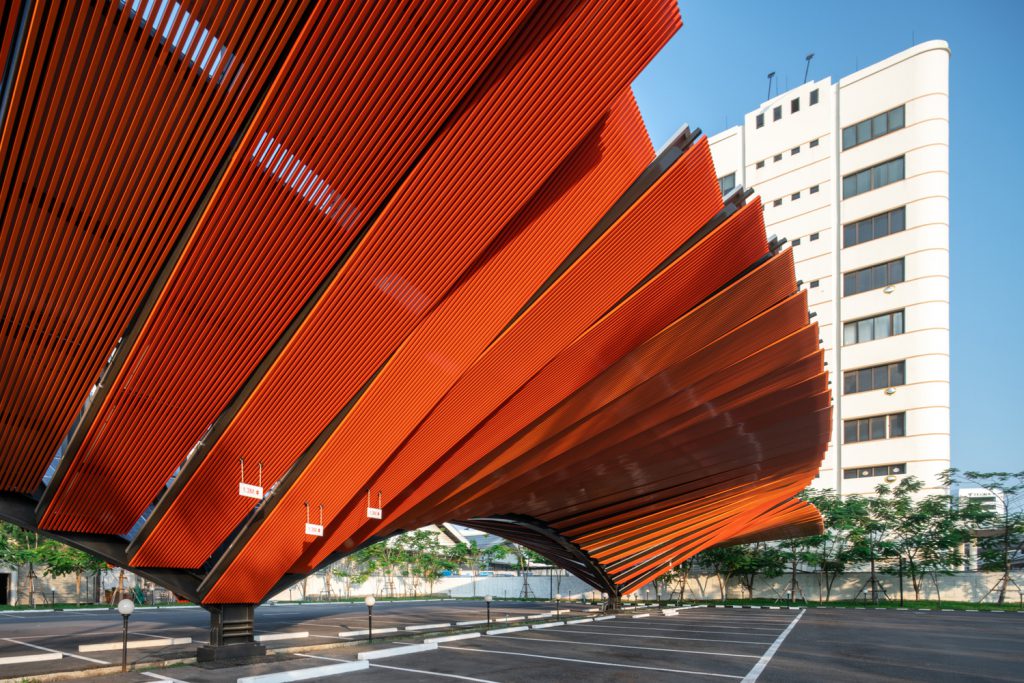
ในมุมมองผู้ออกแบบ การออกแบบหลังคาที่จอดรถพร้อมกับแผงโซล่าเซลล์นั้น หากมองในเชิงของประโยชน์ใช้สอยเพียงอย่างเดียวอาจจะเหมาะสม และไม่ต้องการอะไรมากไปกว่านั้นในการออกแบบ แต่ไม่ใช่กับ Openbox ที่มองเห็นแนวทางในการทำงานที่ต่างออกไป โดยนอกเหนือจากประโยชน์ใช้สอยแล้ว ผู้ออกแบบมองเห็นถึงความเป็นไปได้ในการสร้างภาพลักษณ์ใหม่ๆ ให้กับองค์กรผ่านผลงานชิ้นนี้ ด้วยที่ตั้งของลานจอดรถที่อยู่ติดกับถนนกรุงเทพกรีฑา ซึ่งเปรียบเสมือนด้านหน้าของโครงการ ทำให้กลายเป็น Front Gate ของบริษัทแทน เพื่อให้กลายเป็นภาพจำที่แสดงถึงภาพลักษณ์ขององค์กรได้
“เราพยายามเปลี่ยนโจทย์ทั้งหมดว่า ลานนี้ตั้งอยู่ด้านหน้าชิดติดริมถนน คนขับรถผ่านเส้นนี้วันละแสนคัน เราจะทำ Sculpture ชิ้นหนึ่งที่มี Identity ขององค์กร ที่สามารถจอดรถได้ บังแดดให้รถได้ คิดเป็น Sculpture ที่ทำหน้าที่เป็น Signage เป็นทุกสิ่งทุกอย่าง ซึ่งเราต้องขอบคุณทีมทุกคน ที่มองเห็นว่าความคิดนี้นั้นเป็นไปได้” Openbox กล่าวถึงไอเดียในการทำงาน
สิ่งหนึ่งที่ยากในการออกแบบ คือการสร้างความเชื่อมั่นให้กับเจ้าของโครงการ ด้วยงบประมาณที่จำกัดนั้น รูปแบบของงานที่เปลี่ยนไปส่งผลให้มีปัจจัยที่ตามมาด้วย จึงเป็นการพูดคุยเพื่อหาความสมดุลของผลงาน แบบที่ทำออกมาจึงต้องแสดงถึงศักยภาพขององค์กรได้อย่างเต็มที่ และคุ้มค่ากับการลงทุน ผู้ออกแบบจึงพยายามที่จะผสมผสานองค์ความรู้ที่หลากหลาย ทั้งงานสถาปัตยกรรม งานวิศวกรรม และความเป็นงานประติมากรรม ให้แสดงออกมาอย่างชัดเจนในทุกมิติของงาน
จากการทดลอง Sketch เพื่อหาความเป็นไปได้ ทั้งในแง่ของโครงสร้างและความงาม เพื่อหาความสมดุลในทุกๆ แง่ ด้วยโครงสร้างที่เป็น Long Span กว้าง 50 เมตร โดยใช้เสาเพียง 2 ต้นเพื่อเป็น Structure หลัก โดยผ่านการคำนวณในแง่ของโครงสร้างมาอย่างดี เพราะนอกจากน้ำหนักของโครงสร้างแล้ว ยังต้องรับน้ำหนักของแผ่น Solar Cells ทั้งหมด 256 แผ่น โดยจัดวางบนโครงสร้างที่ถูกออกแบบให้เป็นเสมือนปีก ถูกแบ่งออกเป็นเส้นตามความกว้างของแผง และยื่นออกไปทั้งด้านหน้า ด้านหลัง โดยระยะจากเส้นศูนย์กลางฝั่งละ 6 เมตรโดยประมาณ เพื่อให้สามารถติดตั้งแผง Solar Cells ได้อย่างพอดี ตามขนาดมาตรฐาน ซึ่งด้วยระยะนี้ทำให้การออกแบบโครงสร้างวัสดุต่างๆ สามารถคำนวณได้โดยง่าย และใช้วัสดุอย่างลงตัวตามขนาดมาตรฐานเช่นเดียวกับยูนิตของแผง Solar Cells และด้วยจำนวนของแผงทั้งหมดนี้ สามารถสร้างไฟฟ้าที่เพียงพอสำหรับสำนักงานด้านข้างที่เป็นอาคาร 2 ชั้นได้เกือบ 100 % แต่ละเส้นโครงสร้างถูกออกแบบให้บิดแกนเล็กน้อยเพื่อสร้างมุมมองใหม่ๆ ให้เกิดขึ้น โดยที่ยังคงไม่เสียประสิทธิภาพในการรับแสงแดดเพื่อสร้างพลังงาน อีกทั้งยังสามารถดูแลรักษาง่าย ด้วยการออกแบบโครงสร้างทางเดินตลอดแนวหลังคา เพื่อที่จะทำความสะอาดจากด้านบนได้ทั้งหมด รวมถึงการบำรุงรักษาในกรณีที่เกิดปัญหา เพื่อลดความเสี่ยงที่จะเกิดขึ้นจากการใช้งานระยะยาว โดยผ่านการทำงานร่วมกันกับทีมต่างๆ ในการวางแผนการติดตั้งแผง Solar Cells ทั้งหมดนี้
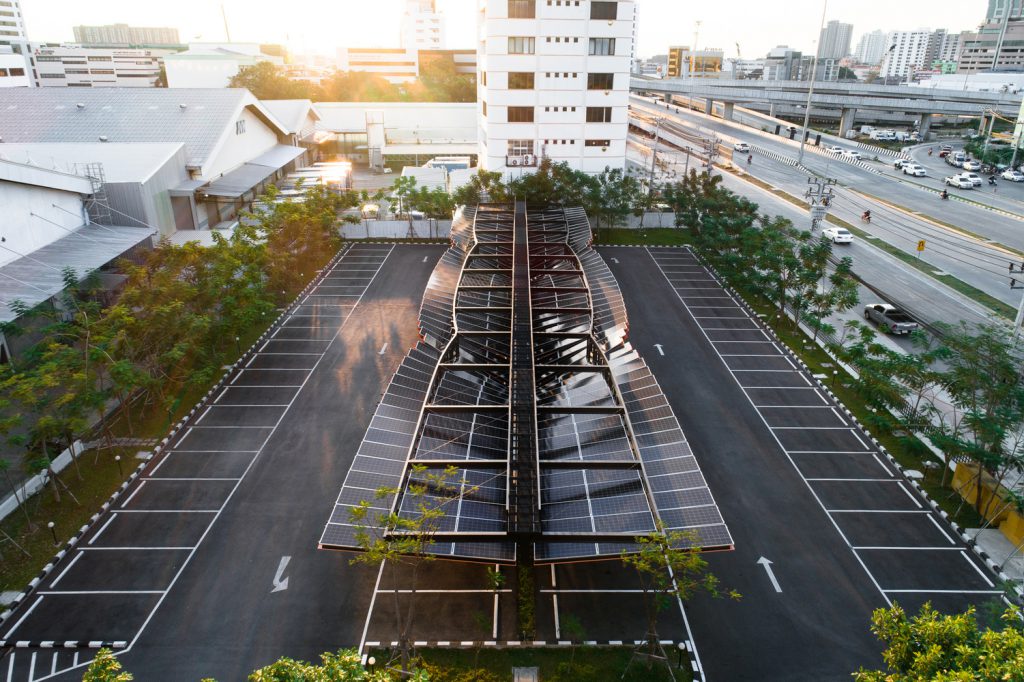
สำหรับมุมมองจากผู้ใช้งานด้านล่างนั้น Openbox ออกแบบให้เป็นระแนงอลูมิเนียม เพื่อปิดส่วนที่เป็นงานระบบ และโครงสร้างจากด้านบน โดยเลือกใช้สีส้ม ที่ทางองค์กรเป็นผู้เลือก พร้อมทั้งบิดแกนตามโครงสร้างของแผง Solar Cells จนเกิดเป็นฟอร์มของฝ้าหลังคาที่ถูกบิดไปมาอย่างมีจังหวะ เกิดเป็นมุมมองที่แปลกตาสำหรับผู้ที่พบเห็นจากภายนอก และผู้ที่ใช้งานภายในโครงการ ซึ่งแนวความคิดของโครงสร้างและการตกแต่งทั้งหมดก็เกิดมาจากการตั้งคำถามจากโจทย์ที่ได้รับ และพยายามต่อยอดการทำงานออกไป จนเกิดเป็น Sculpture ขนาดใหญ่ที่แสดงตัวออกมาอย่างชัดเจน จนกลายเป็นเสมือน Landmark ของบริษัทไปด้วยในตัว
หลังจากที่ผ่านการทำงานร่วมกันจากหลายๆ ฝ่าย จนทำให้สิ่งนี้กลายเป็นมากกว่าที่จอดรถ แสดงในเห็นถึงภาพลักษณ์ขององค์กร และศักยภาพที่สื่อออกมาผ่านงานวิศวกรรม และประโยชน์ใช้สอยที่ซ่อนตัวอยู่ภายใต้โครงสร้างที่ดูตื่นตาตื่นใจ ทำให้เห็นว่าไม่ว่างานออกแบบใดๆ นั้น หากมีความความคิดสร้างสรรค์ และสามารถสื่อสารเพื่อให้เกิดความเข้าใจได้ ว่าสิ่งที่คิดในตอนเริ่มต้นนั้น สามารถพัฒนาจนเกิดเป็นสิ่งใหม่ได้ ทั้งนี้ความคาดหวังในแง่ของการตอบโจทย์นั้น ก็ถูกแปรเปลี่ยนให้เป็นการแสดงออกที่ชัดเจน และสื่อสารกับผู้ที่พบเห็นได้มากกว่าเดิม นี่จึงเป็นเสมือนมุมมองใหม่ๆ ของการออกแบบเพื่อตอบสนองแนวความคิด Circular Living ที่นอกจากจะคำนึงถึงการใช้พลังงานหมุนเวียนแล้ว ยังสามารถประยุกต์งานออกแบบให้สร้างมูลค่ามากกว่าเดิม ทั้งทางเศรษฐกิจ ความงามในเชิงวิศวกรรมและสถาปัตยกรรม
For a resident, circular living means having a home with efficient management of electricity, water, and other resources focused on creating a positive relationship with the earth. For large-scale development such as an office building, including design principles such as energy management allows for systemic planning of energy usage for conservation purposes, this benefits the owner, users, and ultimately the planet.
The designer however faces additional challenges when considering building renovation works apart from energy and water resource management. These include space management, value for the investment intended or provided, and suitability for the original context. If the designer and the project owner hold the principles in terms of sustainability, the project itself will become more cost-effective and efficient.
Power Wing is a project of ‘B Grimm’, an old engineering firm that has been producing electric power and renewable energy for more than a century and has collaborated with Openbox Architects on many projects. Openbox has long been interested in zero waste energy, so the company coordinates its architectural designs with B Grimm’s engineering design. Unexpectedly, this particular project initially started as a mere roof structure for a vehicular parking lot.
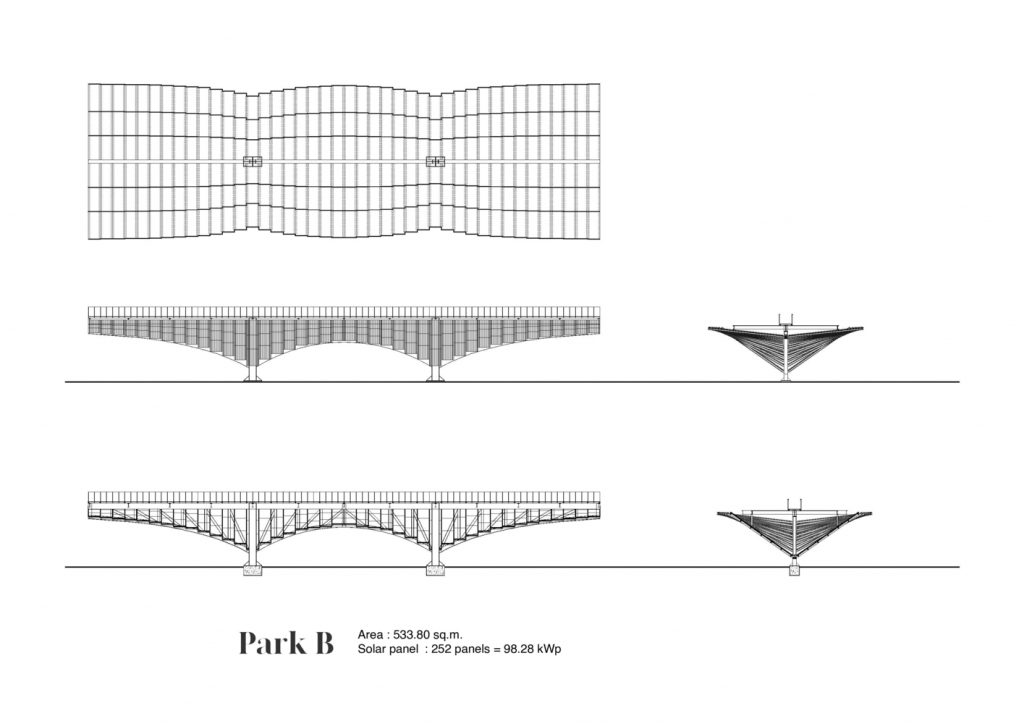
From the usual perspective of a designer, as far as functional sustainability goes, a parking lot roof with mounted solar cell panel(s) would likely suffice for the design without anything else being added. Openbox takes a differing design approach. They consider how they can create new organizational imagery through their work. The parking lot, located on the Krung Thep Kritha road deemed the front of the site was designed to aby B Grimm as a ‘front gate’ and serves as a symbol of the company’s identity.
“We tried to expand our ideas on the basis that the parking lot is located in front of the company, on a road that sees a hundred thousand cars travel past every day. We wanted to design a visual and functional sculpture reflecting the organization’s identity that can be utilized for signage purposes and shaded car parking. In other words, the structure serves multiple tasks, and we thank everyone involved for the ideas and outcome.” said the architect.
As is well established, difficult aspects of designing include establishing and maintaining the project owner’s confidence as well dealing with limited budgets and design changes. It is therefore paramount to establish an agreed equilibrium through consultation. The consultation may include the project’s potential and value on investment which are means by which a project can ultimately be delivered. In this instance, B Grimm saw the opportunity in expressing these advantages in terms of the multiple architectural, engineering, and artisan disciplines required for the project work.
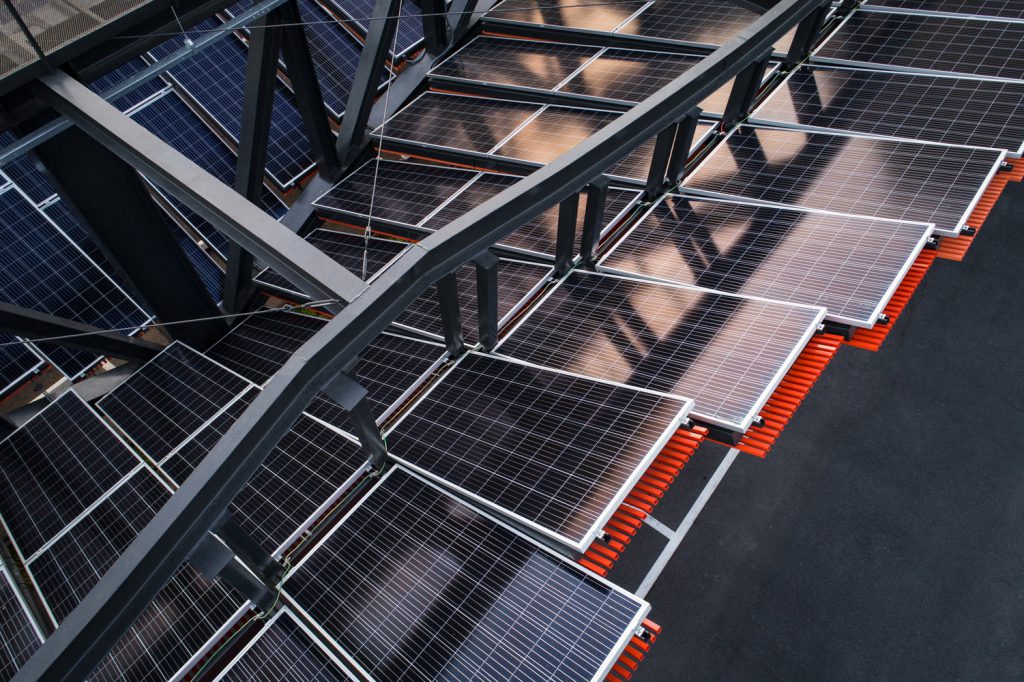
The design included freehand sketching which was used to establish initial concepts for both the structure and the aesthetic. The structure is some fifty meters long supported by only two pillars. Meticulous calculations were applied considering several factors such as structural dead weight and applied loads including extensive solar cell panels (256 in total). Solar panels were installed onto the wing-like structure designed through a series of line work attuned to accommodate individual panel widths. The lines themselves extend approximately six meters from the centerline of the structure front and back to accommodate standard size solar cell panels. Sizing allowed for easier calculation in relation to both the structural design and material applications. Ultimately, these panels will provide close to 100% of the electrical power required to service the adjacent two-storey commercial office building.
Additionally, the axis for each line of the paneling in the structure has a small twist which creates differing perspectives while retaining the ability to absorb sunlight and produce energy. A catwalk is also installed along the length of the structure for monitoring and maintenance purposes. Solar cell planning and installation were coordinated between different teams. The architect applied orange-colored aluminum lath to the structure’s soffit which obscures technical and structural components. The axis of the soffit lining mimics and contrasts against the solar paneling axis application above to create a striking appearance through the twisting of each axis in rhythm. Every design concept stemmed from examining the initial brief and considering the project’s potential which results in a large sculpture that has subsequently become a landmark of sorts for B Grimm.
Power wing has become more than just a parking lot through the collaboration of all involved parties, an eye-catching identity borne of positive examination, consideration, agreement, and engineering work. It defines the potential in understanding, expectation, and creativity that can be applied to any design process in communicating the design work intent. Ultimately, these principles can be applied in essence to the concept of ‘circular living’ where a design can be adapted to create more value in terms of sustainability, renewability, economy, engineering, and architectural practices and aesthetics.


